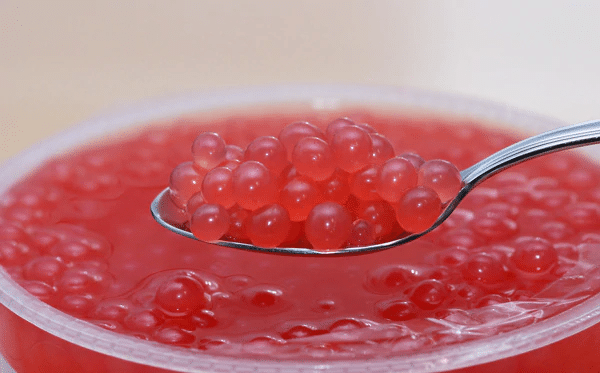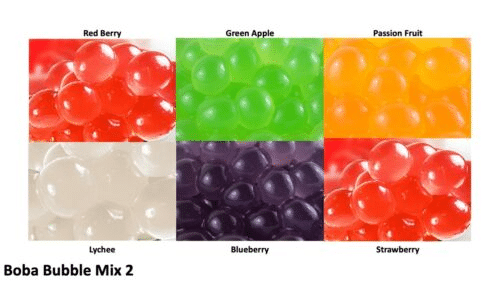Popping boba is a type of bubble tea that has a small, chewy ball inside the drink. It is typically made of tapioca pearls, which are made from the starch extracted from cassava root. The balls are then coated in sugar and other ingredients.
The taste of this drink changes depending on the ingredients used. It can be sweet, sour, or salty, and it can even have fruit flavours added to it.
The popping boba is also known as pearl milk tea because the balls look like pearls when they are mixed with a tea-based beverage such as black or green tea.

What are the materials that makeup Popping Boba?
This sweet treat is known to most bubble tea drinkers. When pressed or bitten, the jelly-like ball bursts. Fruit juice is used as the basis for these pearls. A coffee base is also possible with black and green teas. How do they get their unique texture?
There are two food additives that alter the texture, sodium alginate and calcium salt. The mouthfeel of pop boba is determined by these additives. Molecular gastronomy, a lesser-known cooking discipline, uses these perfectly safe tools. Even though these additives may seem strange and dangerous to non-specialists, rest assured that they do not cause health problems. In addition to its use in ice cream, cheese, and even instant noodles, sodium alginate is used by chefs for many other purposes.
You may have difficulty finding these two additives if you live in an area with limited availability of online shopping. Our alternative method relies on agar-agar powder, a product that is more widely available. Popping boba is not an exact recipe, but you can use it as a good substitute. People who are not comfortable using actual additives will find this useful.
Boba vs Popping Boba: What’s the difference?
The major and most obvious difference between the two desserts is the use of tapioca flour in the former and juices in the latter. The differences are many, though.
Its texture is heavier and chewier. Popping boba, in contrast, is considerably lighter and easier to handle. Biting into the latter releases a sudden burst of liquid that soothes a thirsty mouth. It is in almost all bubble tea drinks, as well as in pastries, cakes, ice creams, puddings, and ice creams. Tapioca pearls normally come as the default topping choice when you purchase a bubble tea home kit from a shop. In contrast, fruit pearls are less versatile and more specialised. Drinks and frozen desserts can be enhanced by fruit pearls. Mango pearls can be paired with mango milk or plain milk, and strawberry pearls can be paired with cheesecake drinks. There is no end to the combinations! Less commonly, however, tea-based drinks are made with them. Fizzy drinks and milk are most commonly made with them.
More About Popping Boba
Molecular gastronomy, or the ‘science of the chemical reactions that happen during cooking,’ is a technique used to create popping boba. Spheres are created through this process. This method was developed by restaurants in the 1950s. As a method of catalysing spherification, chefs use calcium lactate, sodium alginate, and calcium chloride. In addition to forming delectable spheres, these ingredients provide a thin shell that bursts when squeezed.
A syringe or dropper can be used at home to form pearl shapes to accomplish this process. You should invest in a caviar maker if you wish to make them on a larger scale. Such a device plays an important role in molecular gastronomy. Popping pearls are made from a juice or liquid mixed with sodium alginate. In order to stabilise the pearls and achieve a thin exterior coating, this liquid is dropped into a calcium salt solution. In order for the textures to be perfect, the salt ratios must be precise. You can make the ideal fruit boba if you follow our recipe exactly!
Calories
Since the only ingredient is fruit juice, these boba pearls have much fewer calories than regular boba pearls. In other words, 30 calories are contained in 30 grams of these pearls.
Making homemade popping boba from black coffee or tea is a great way to save calories when consuming boba drinks. As it is made using a beverage, however, it does not contain protein and fat.
Flavours
Fruit pearls are mainly made from fruit juices, as their name implies. Various flavours of popping boba are available at tea shops, such as strawberry, mango, and lychee popping boba. You can make pearls from virtually any liquid – even water itself because spherification uses a science-based process.
Due to the calcium factor, the sodium will clump if calcium is present in the liquid. It is advisable to avoid dairy products or fruit juices high in calcium (like orange juice). Spherification can also be reversed. The following process will allow you to make calcium-rich fruit boba using high-sugar liquids. The additives used in that case are different, however, so we won’t discuss that here.

Ingredients
We use calcium lactate in our recipe, along with sodium alginate and calcium salt as chemical additives. The majority of the pearl is made from fruit juice. If you want the colour to be vibrant, sweeten the dough with sugar first. Last but not least, distilled water is needed to make sure there are no calcium radicals in the sodium alginate solution. If there are calcium radicals, the solution will be set and ruined.
Other than these, water also plays an important role. Chemistry is basically the purpose of this experiment.
Conclusion: Is Popping Boba Healthy for the Body?
The boba tea bubble has been around for a while now. But is it healthy?
The answer is yes, but only if you know what type of boba you are drinking. There are different types of bobas with different benefits and risks.
Frequently Asked Questions
The answer is no. The gelatin in the boba tea is not made with pork bones and cow bones like the gelatin we use to make jello.
A lychee popping boba is a drink that is made from a tea-based slushie. It is usually served in a large glass with ice and milk, and it has a sweet taste.
The drink is made by adding lychee fruit to the tea slushie base. The fruit helps to make the drink refreshing, but it also adds sweetness to the slushie.






